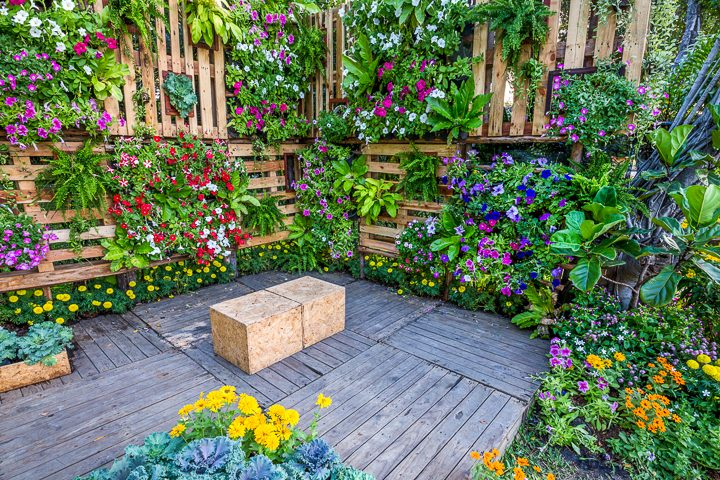Growing plants upward rather than outward is an inspired way to make the most of tight spaces. It’s become a popular choice in city life, where every metre counts and beauty must meet function.
Whether it’s inside your home or tucked into an outdoor corner, a vertical garden can breathe life into forgotten spaces. Imagine aromatic herbs climbing along a kitchen wall or bright flowers pouring down from a balcony.
Here’s how to bring that idea to life.
The Concept of Upward Growth
This inventive style of gardening fits neatly into compact settings. It breaks away from traditional layouts by lifting greenery onto walls, screens, or any upright surface.
Planters fixed to vertical structures or densely packed plant panels can create stunning living arrangements.
They reduce mess while offering a bold visual statement. Plants like spider ivy, peace lilies, and trailing pothos all adapt beautifully when raised above the ground.
The real magic is in their versatility. These displays work just as well indoors as they do outside. A bland office divider becomes a canvas for green texture, and the front of a building softens under a curtain of foliage.
They’re more than just decorative, too. Vertical gardens can reduce noise and improve the air you breathe.
So, why not rethink a bare balcony as a shaded hideaway? Or turn an empty wall into a fragrant patch of culinary herbs?
Choosing the Right Location
Where you place your garden can make or break its success. The first step is to study how much light the spot gets throughout the day. Most plants favour at least six hours of sun.
That said, areas that overheat can be too harsh for certain varieties, while windy corners could strip moisture too quickly. It’s about finding a space that offers both light and shelter.
Keep practicality in mind. Position the setup near water access and tools for easy upkeep.
Inside, these gardens offer a fresh feature—ideal for kitchens or even bathrooms. Outdoors, they sit naturally beside patios or balconies, adding softness to stone or metal surfaces.
Furthermore, use height and tilt to shape your arrangement. Showcase standout plants higher up and let others hang freely to create gentle movement.
Remember to consider warmth and dampness in your chosen spot. They have a strong influence on how well everything grows.
Selecting Suitable Plants
The success of your green wall depends on the plants you pick.
Start by reviewing the amount of daylight and the size of the area. Go for fuss-free varieties that suit the setting. Sunlight plays a big part—many plants need steady exposure to do well.
Keep an eye on heat levels, though. If things get too warm, growth can suffer. Strong breezes can also cause stress, so aim for a spot with mild airflow.
To make things easier, place your system where water and tools are close at hand. Inside the home, these plants can brighten a cooking space or bring calm to a washroom. Outside, they mix well with walls and railings, adding charm without taking up floor space.
Arrange plants at different heights and angles. It draws the eye and gives your display dimension.
Pay attention to the conditions around your installation as well. Air temperature and moisture shape how your garden will behave over time. With the right mix, care becomes less effort and more enjoyment.
To take your planting design a step further, combine plants with contrasting leaf textures, colours, and growth habits.
For example, pair the bold leaves of Swiss chard with the trailing stems of creeping Jenny, or place upright rosemary beside cascading English ivy.
Blend perennials like heuchera or ferns for lasting structure with fast-growing annuals like nasturtiums or begonias for seasonal bursts of colour.
Where possible, favour native or climate-adapted species.
Lavender, sedum, and coreopsis, for instance, are hardy choices that require less water, resist pests, and thrive with minimal upkeep, making your vertical garden more sustainable and self-sufficient over time.
Exploring Different Systems
When you’re short on floor space, this approach offers a clever alternative. Several systems are available, from fabric containers to freestanding grids and wall panels.
Soft pockets are ideal for smaller spots and can be moved when needed. Sturdy frames support climbing types and create striking backdrops for trailing stems. If you prefer something structured, go for sectional wall units.
Moreover, think about cost when choosing. Hanging frames and light setups are usually less expensive and flexible. Modular panels cost more but bring a sleek, custom feel that can be worth the extra.
If you enjoy hands-on work, building your own setup can be rewarding. There are plenty of how-to guides online.
Prefer not to get your hands dirty? Local garden landscapers can handle the planning and building for you, including all the less glamorous details like drainage and feeding.
Maintenance Tips
Caring for a vertical seems a bit daunting at first, but with the right habits, it quickly becomes second nature. A thoughtful approach helps keep your display healthy, attractive, and long-lasting.
Watering and Drainage
Watering, for instance, needs a touch of consistency. Too little, and foliage becomes brittle; too much, and roots may sit in dampness they don’t appreciate.
A well-calibrated drip setup can help manage this balance, especially in a climate where rainfall can be either a blessing or an interruption. Ensure moisture flows through freely—stagnation is no friend to thriving roots.
Pruning and Feeding
Regular grooming, such as snipping off tired leaves or thinning dense patches, not only encourages renewed development but also prevents mould and mildew from settling in unnoticed.
Natural feed tends to be gentler, enriching the soil without disturbing the micro-ecosystem that forms organically over time.
Keep an eye out for subtle changes—yellowing edges, curling tips, or sudden drops in foliage—all signs your display may be asking for something different.
Encouraging Balance
Living walls also benefit from rotation where feasible. Even houseplants can become lopsided or overly light-seeking if not occasionally repositioned.
Introducing companion varieties, a method where specific species support one another’s well-being, can help deter infestations and reduce the need for chemical measures.
Marigolds, for example, can act as natural defenders against aphids when placed near delicate herbs.
Circulation and Support
One often overlooked aspect is circulation. A setup that’s too tightly packed can restrict ventilation, leading to humid pockets that invite disease. Make sure the arrangement allows for gentle airflow between specimens.
It’s also worth checking your attachment points now and then. Brackets, screws, and fixtures can loosen gradually, particularly in exposed environments. A quick tightening now saves a potential collapse later.
Seasonal Light Adjustments
Lastly, don’t forget the light. As seasons shift, so does the sun’s trajectory. If your garden did well in the soft light of spring, it might not do as well in the low light of winter.
Adjusting positioning, or supplementing with artificial lighting indoors, can preserve the vitality of your greenery when natural brightness becomes scarce.
Conclusion
Even the smallest space can come alive with a vertical garden. With a little planning and the right choices, your wall can turn into a thriving slice of nature.
Starting is easier than you expect. With different systems to suit every taste and budget, there’s something for everyone.
Also, if you’re not sure where to begin or want a guiding hand, expert landscapers can help bring your idea into bloom and keep it flourishing.

